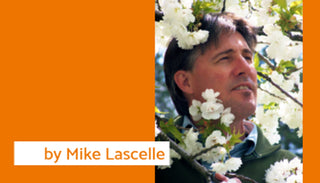I recently had the opportunity to visit Mexico City with my oldest daughter, Nicole. The plan was to turn off my inner gardener (something I tend to do on vacation anyways), visit as many art galleries and Diego Rivera murals as possible, eat some interesting local food and just marinate in the local culture. This was somewhat disrupted during a planned visit to the Frida Kahlo Museum when I was reminded that art, architecture and landscape can be integrated to such an extent, that one does not exist without the other, they simply become one entity.

(📸 MK Lascelle)
La Casa Azul or The Blue House was built in 1904 in the village of Coyoacan (‘place of coyotes’), which would eventually become a borough of Mexico City. More importantly, it was her family home in the truest sense of the phrase, as Frida was born here in 1907 and forty-seven short years later, she would pass away in her upstairs bedroom – so her life came full circle within these walls. That passion is evident in the carefully curated displays of Frida’s and Diego’s personal effects found here, everything ranging from Mexican folk art (the papier-mâché monsters are superb), photos, letters, local pottery, books, pre-Hispanic artifacts and a few pieces of their personal art collection.

(📸 MK Lascelle)
One of the first indicators that I needed to turn my inner gardener back on was a stunning botanical painting, Naturaleza Muerta (1942), which richly illustrated Frida’s love of the natural world through detailed images of squash, zinnias, citrus and cacti. Then I walked by her bookcase and noticed a modest Tree Guide (as well as other botanical tomes) and also later learned that her personal copy of Walt Whitman’s Leaves of Grass held a small, pressed flower bouquet between its pages that was discovered after her passing. I leisurely pondered her last painting, the 1954 Viva la Vida, which at a casual glance just appears to be a still life of watermelons but somehow it seemed to rekindle the memory of eating a fresh, juicy slice as a child and feeling the pure unadulterated joy that went with it.

(1942 Naturaleza Muerta | 📸 MK Lascelle)

(1954 Viva la Vida | 📸 MK Lascelle)
Every room here seems to have a perfect vista of the courtyard garden, but the house was not originally designed that way. All of the windows facing the streets were walled in with adobe brick and a high wall was built in 1937 to protect Leon Trotsky and his wife Natalia, who stayed as guests for two years, until 1939. After her father died in 1941, Frida moved back to La Casa Azul and Diego finished enclosing the courtyard at that time. He also commissioned new additions made of black volcanic rock richly embellished with abalone and conch shells, pottery and artifacts – making the outdoor space as cultured as the bedrooms, kitchen, dining room or even Frida’s red-tiled studio, which has a panoramic view of the garden. It had the effect of compelling me to go outdoors, to the living space that once soothed the souls of both these great artists.

(📸 MK Lascelle)

(📸 MK Lascelle)
There are many plant species commonly found in Mexico here, including Jacaranda, palms, banana, agave, cacti and pomegranate, but the mature trees thriving here have made this an open shade garden over time. I also recognized a few species that we have back home in British Columbia, such as Bergenia, Deer Fern (Blechnum), Yucca, Honey Locust (Gleditsia triacanthos) and even Monstera, which is growing as a hardy outdoor climber. There was little in flower when I was visiting in October, with the exception of a purple Bougainvillea growing to one side of the stairs which bring you down into the courtyard. Despite this, green foliage dominates this garden, and its verdant splendor is perfectly accented by the cobalt blue walls of the courtyard, a hue which both Frida and Diego chose.

(📸 MK Lascelle)
Of course, there are other colours at play here including an ochre and canary yellow pyramid displaying well-spaced pre-Hispanic artifacts. Vermilion concrete walkways and golden walls can also be found adjacent to the residence, where the blue, red and yellow literally fight for your attention. But in the garden proper, you are only confronted by green and cerulean, occasionally accented by half-hidden Mexican artifacts of carved stone. One of these, which resembles a well-worn monkey’s head nestled in deer fern, turns out to have once been a favoured headrest for Diego Rivera as evidenced by a nearby plaque featuring a vintage photograph of him and his dogs resting in the shade.

(📸 MK Lascelle)

(📸 MK Lascelle)
In the end, I found that Frida’s garden had just as much presence as her paintings, and it was a privilege to experience both in person, because in each can be felt something of her essence which is why we all need to encounter art in person. Every plant, every hue, every artifact here seemed to be saying the exact same thing in perfect unison, Viva la Vida or long live life, that basic human desire that all of us understand.

(Viva la Vida 1954 | 📸 MK Lascelle)

(📸 MK Lascelle)
Copyright 2025 MK Lascelle


